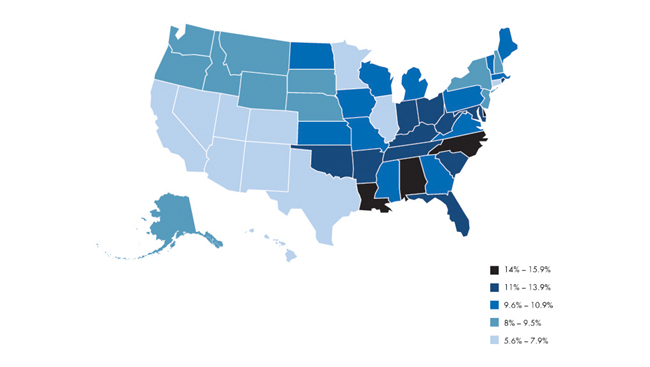Confronting Attention Deficit Hyperactivity Disorder
- Published8 Nov 2012
- Reviewed8 Nov 2012
- Author Marilyn Fenichel
- Source BrainFacts/SfN
Most of us can remember a classmate who could never sit still. If he wasn’t getting up and pacing the room, he was tapping his pencil on the desk or kicking his feet. And then there was the one who sat in the corner, daydreaming and looking out the window. She never disrupted the class, but when called on to participate, she might not know what was going on.

Credit: Courtesy of the Centers for Disease Control

Credit: Image used under license from Shutterstock.com.
Today, both of these children might be evaluated for ADHD. First diagnosed 100 years ago, the disorder is characterized by excessively inattentive, hyperactive, or impulsive behaviors. Symptoms include having trouble focusing, interrupting conversations or activities, and missing important social cues.
In recent years, the diagnosis of ADHD has become common. Between 5 and 8 percent of school-aged children in the United States have been diagnosed, with boys outnumbering girls nearly three to one. About 60 percent of children diagnosed with ADHD will continue to show symptoms well into adulthood. ADHD is prevalent in many other industrialized nations as well. Recent studies suggest that the prevalence in Canada and Europe is comparable to that in the United States. This becomes particularly evident when those countries use similar diagnostic criteria.
Regardless of location, ADHD also comes with a steep economic price. Based on a 5 percent prevalence rate, recent estimates indicate ADHD costs between $32 billion and $56 billion each year in the United States alone.
Potential Causes
Researchers are learning more about what causes ADHD. Twin and family studies show that ADHD has a strong genetic influence. One study found that more than 25 percent of parents with ADHD had children with the disorder.
Genes involved in the transmission of the neurotransmitters dopamine and norepinephrine have been implicated. In addition, recent imaging studies have shown reductions in the transmission of these so-called catecholamine neurotransmitters in at least some people with the disorder. Because prefrontal brain circuits, which are normally involved in cognitive control, require an optimal level of catecholamine stimulation, reduced catecholamine transmission could potentially lead to the weakened regulation of attention and behavior in ADHD.
Altered brain activity also has been observed in circuits connecting the cortex, striatum, and cerebellum, particularly in the right hemisphere. Recent studies show a delay in cortical development in some children with ADHD, although most individuals with ADHD do not outgrow the disorder as they mature.
Children with ADHD often have cognitive deficits as well. Research has shown that many people with ADHD have difficulties with executive functioning, which includes the ability to maintain and manipulate information in the short term, as well as planning and motor control. Particular deficits have been reported in processing visual-spatial information. This can translate into specific academic issues, such as difficulties with math skills related to geometry, difficulty reading maps, and problems with spatial relations.
Treatment Options
Treating ADHD often includes behavioral and pharmacological approaches. On the behavioral side, children can be taught strategies for staying on task, such as following a detailed schedule, or for organizing materials. Sometimes a physician determines that behavioral support is not enough. Many children with ADHD may also need medication. Since the late 1960s, stimulants such as Ritalin® or Adderall® have been prescribed to treat children with ADHD. Currently, between 4 and 6 million children in the United States take one of these medications, which reduce hyperactivity and impulsivity, help improve the ability to focus, and even improve physical coordination. In fact, medications are so effective in helping people with ADHD that a recent shortage wreaked havoc for many families.
Nonetheless, many parents express concern about giving their children a drug that is potentially addictive. Cocaine and methylphenidate, the active ingredient in Ritalin, act similarly to inhibit their brain targets, the catecholamine transporters. Further, many wonder whether ADHD is over-diagnosed, leading to the diagnosis and treatment of high-energy children who have difficulty in the classroom, but are medically normal.
Only better understanding of ADHD and the medications used to treat it will answer these concerns. Many researchers are pursuing this path, studying ADHD’s underlying mechanisms and working toward developing new tools for managing and deepening knowledge of this increasingly common disorder.
CONTENT PROVIDED BY
BrainFacts/SfN
Also In Archives
Trending
Popular articles on BrainFacts.org


















